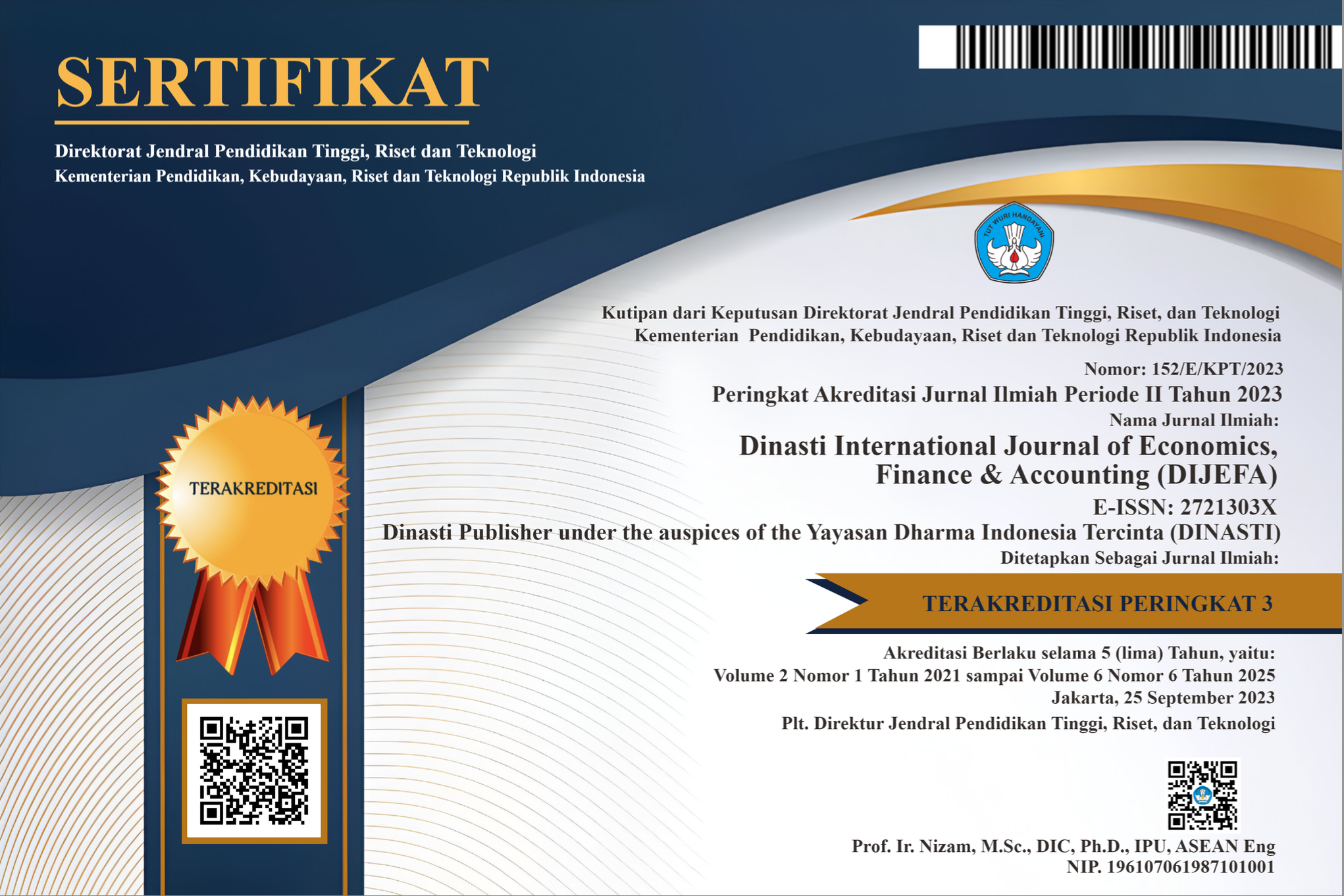The Capital Structure Theory as It Relates to The Food Sector. A Developing Economy's Evidence
DOI:
https://doi.org/10.38035/dijefa.v4i3.1914Keywords:
Capital Structure, Firm Value, Debt, EquityAbstract
The study's objective was to investigate the capital structure theory in the food industry, focusing on manufacturing companies listed in Zimbabwe. By looking at these companies' capital structures, we aimed to pinpoint the factors influencing capital structure decisions in the food industry and provide managerial implications for businesses operating in this market. From 2017 to 2022, the study used Panel data from the financial statements of manufacturing companies listed on the Zimbabwe Stock Exchange and Victoria Falls Stock Exchange. The findings demonstrate the importance of business value and capital structure despite their negative relationships. For a variety of stakeholders, the study has value implications. This study offers managers in the food business insights into the variables influencing firms' capital structures, empowering them to make educated decisions about their financing options. The study can also be used by investors in this industry to assess the capital structure of businesses they are considering investing in, which will ultimately help them make more educated choices. Additionally, policymakers can use the study's findings to create policies that support the expansion and development of Zimbabwe's food business, thereby boosting that nation's economy.
References
Abrar, A. and Javaid, A. Y. 2016. The impact of capital structure on the profitability of microfinance institutions. South Asian Journal of Management, 10 (1): 21-37.
Aggarwal, D. and Padhan, P. C. 2017. Impact of capital structure on firm value: Evidence from Indian hospitality industry. Theoretical Economics Letters, 7 (4): 982-1000.
Anderson, T. W. and Hsiao, C. 1982. Formulation and estimation of dynamic models using panel data. Journal of Econometrics, 18 (1): 47-82.
Aquino, R. 2010. Capital structure of Philippine listed and unlisted firms: 1997-2008. University of the Philippines, College of Business Administration. Discussion paper 1005.
Awunyo-Vitor, D. and Badu, J. 2012. Capital structure and performance of listed banks in Ghana.
Blundell and Bond. 1998. Initial conditions and moment restrictions in dynamic panel data models. Journal of Econometric, 87: 115-144.
Ceballos-Mina, O. E. and Santiago-Ayala, L. E. 2019. Capital structure-firm value nexus: The moderating role of profitability. Revista Finanzas y Política Económica, 11 (2): 375-386.
Chadha, S. and Sharma, A. K. 2016. An empirical study on capital structure in Indian manufacturing sector. Global Business Review, 17 (2): 411-424.
Dhankar, R. S. and Boora, A. S. 1996. Cost of capital, optimal capital structure, and value of firm: An empirical study of Indian companies. Vikalpa, 21 (3): 29-36.
Dickson, P., Marobhe, M. and Kaaya, I. 2013. The Relationship between Capital Structure and Commercial Bank Performance: A Panel Data Analysis.
Dodoo, R. N. A., Kumi, M. and Mangudhla, T. 2023. The effect of capital structure on firm performance: empirical evidence from emerging economy. EuroMed Journal of Management, 5 (1): 83-99.
Flannery, M. J. and Hankins, K. W. 2013. Estimating dynamic panel models in corporate finance. Journal of Corporate Finance, 19: 1-19.
Froot, K., A, and Stein, J., C, . 1998. Risk management, capital budgeting, and capital structure policy for financial institutions: an integrated approach:. Journal of Financial Economics,, 47 (1): 55-82.
Gujarati, D., N, . 2009. Basic Econometrics:. Tata McGraw-Hill Education.
Hart, M. 1982. THE BACKBENCH DIARIES OF CROSSMAN, RICHARD-MORGAN, J, EDITOR: UNIV WALES PRESS 6 GWENNYTH ST, CATHAYSCARDIFF CF2 4YD, S GLAM, WALES.
Hirdinis, M. 2019. Capital structure and firm size on firm value moderated by profitability.
Homapour, E., Su, L., Caraffini, F. and Chiclana, F. 2022. Regression analysis of macroeconomic conditions and capital structures of publicly listed British firms. Mathematics, 10 (7): 1119.
Luu, D. H. 2021. The impact of capital structure on firm value: A case study in Vietnam. The Journal of Asian Finance, Economics and Business, 8 (5): 287-292.
Magomo, N. T. 2020. Does capital structure theory remain relevant under abnormal macroeconomic environment: the case of Zimbabwean manufacturing firms during the period 2009-2018.
Mawanza, W. and Mugumisi, N. 2013. Capital structure and corporate performance: A case for tourism and hospitality sector of Zimbabwe. Global Journal of Commerce and Management Practice, 2 (6): 85-90.
Mazanec, J. 2023. Capital Structure Theory in the Transport Sector: Evidence from Visegrad Group. Mathematics, 11 (6): 1343.
Mbulawa, S. 2020. Determinants of Capital Structure Choices by Listed Firms in Zimbabwe under Hyperinflation and Dollarization. AERC.
Modigliani, F. and Miller, M., H, . 1958. The cost of capital, corporation finance and the theory of investment:. The American Economic Review,, 48 (3): 261-297.
Myers, S. C. and Majluf, N. S. 1984. Corporate financing and investment decisions when firms have information that investors do not have. Journal of financial economics, 13 (2): 187-221.
Natsir, K. and Yusbardini, Y. 2020. The Effect of Capital Structure and Firm Size on Firm Value Through Profitability as Intervening Variable. In: Proceedings of 8th International Conference of Entrepreneurship and Business Management Untar (ICEBM 2019). Atlantis Press, 218-224.
Nursetya, R. P. and Hidayati, L. N. 2020. How Does Firm Size and Capital Structure Affect Firm Value? Journal of Management and Entrepreneurship Research, 1 (2): 67-76.
Suzulia, M. T. and Saluy, A. B. 2020. The effect of capital structure, company growth, and inflation on firm value with profitability as intervening variable (study on manufacturing companies listed on bei period 2014-2018). Dinasti International Journal of Economics, Finance & Accounting, 1 (1): 95-109.
World Bank Group, W. 2023. Economic Policy & Debt: National accounts: Growth rates. World Bank Group:
Xinhua. Zimbabwe's manufacturing industry optimistic despite operational challenges (online). 2023. Available: https://english.news.cn/20230407/f02dfd5e363942e1ba617aeefb96a84a/c.html (Accessed
Downloads
Published
How to Cite
Issue
Section
License
Authors who publish their manuscripts in this journal agree to the following conditions:
- The copyright on each article belongs to the author(s).
- The author acknowledges that the Dinasti International Journal of Economics, Finance & Accounting (DIJEFA) has the right to be the first to publish with a Creative Commons Attribution 4.0 International license (Attribution 4.0 International (CC BY 4.0).
- Authors can submit articles separately, arrange for the non-exclusive distribution of manuscripts that have been published in this journal into other versions (e.g., sent to the author's institutional repository, publication into books, etc.), by acknowledging that the manuscript has been published for the first time in the Dinasti International Journal of Economics, Finance & Accounting (DIJEFA).


























































